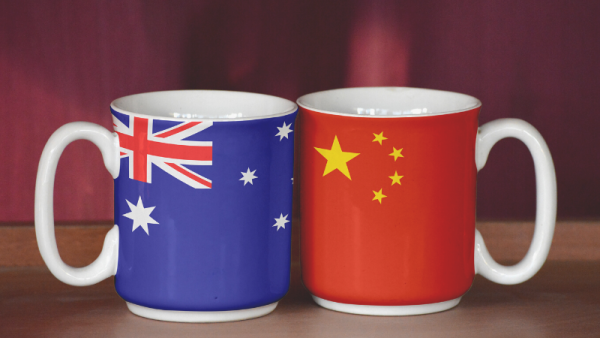Aritra Deb / Shutterstock

Merriden Varrall, Advisory Board Member, Australia-China Relations Institute, University of Technology Sydney |
Perspectives is UTS:ACRI's monthly commentary series, featuring a piece on a topical subject in the Australia-China relationship from an invited expert contributor.
We are in a time of rapid and profound geopolitical change with broad implications across political, economic, social and cultural life. There are several major geopolitical trends which affect the operating environment for Australian businesses, but the major story is the growing strategic competition between our strategic ally, the United States, and our key economic partner, the People’s Republic of China (PRC). While in the past, Australia’s international political relationships had only limited impact on the business community, we are seeing increasing spillover from the political to the business sphere. Australian business is increasingly being swept up in geopolitical tensions which are far outside their control. But given that this uncertainty is the shape of things to come, how are companies facing these risks successfully? [1]
Some sectors of Australian businesses are particularly exposed to geopolitical risk. Unsurprisingly, these are the sectors which depend most on international trade, where business over-relies on one key market or supplier, or where a product from a competitor can substitute for an Australian item. In particular, the Australian education, agriculture, and mining sectors are at higher risk. In these sectors, any escalation in geopolitical tensions can have a rapid and profound impact, not just on the companies involved, but on Australia’s economy overall. [2]
The economic impacts of COVID-19 are running along existing geopolitical faultlines, exacerbating tensions and already-shifting trade relationships. As markets start to reopen, we are likely to see a significant reset of trade patterns as the instinct to re-shore or near-shore comes into play. There will be an ongoing process of renegotiation of prices, supply terms and other trade metrics. Consumers – and governments – are focusing more on product safety and provenance of goods, particularly in the food sector. As countries begin to recover and need to find new markets or new suppliers to continue to function in the ‘new normal’, the geopolitical movements and policies of governments in the region will unsettle the trade system we have been used to.
There are several ways for Australian businesses to respond to this challenge and mitigate risk.
As COVID-19 has demonstrated in no uncertain terms, over-reliance on any supplier or market can be a perilous strategy. Given Australia’s participation in a strong network of multilateral and bilateral free trade agreements, companies have a diverse and growing range of options. For example, the Indonesia-Australia Comprehensive Economic Partnership has just been signed, representing significant potential for Australian businesses.
Multilateral agreements have similar potential to access international markets, but at a broader level. As they involve multiple nations, they present opportunities for intra-regional trade, so exporters can use logistics hubs in the region to supply to other nations in the agreement. Australia is part of multilateral agreements that cover virtually the entire Asia-Pacific region, including with ASEAN and the Pacific Island Nations. Australia is also signed up to the Comprehensive and Progressive Agreement for Trans-Pacific Partnership (CP-TPP) and the Regional Comprehensive Economic Partnership (RCEP).
These agreements provide a range of benefits that are both tariff and non-tariff related that help to streamline business operations when trading internationally. These non-tariff benefits include integrated investment and trade rules, improved e-commerce capabilities, commonality in competition and corruption standards, and cross-country infrastructure development.
Operating in this wide range of locations also allows Australian business to tap into changing consumer trends. Rising incomes and a growing middle class, particularly across Asia, are changing purchasing behaviours in ways that Australian businesses are in a strong position to respond to.
Of course, while diversification can in some cases be a viable option, it can be complicated and costly. Based on many years of deep cooperation, there continues to be enormous potential for successful business with the PRC. Areas where Australians are currently engaging productively include agribusiness, health and aged care, and construction and infrastructure development.
One South Australian olive oil grower is an exemplary Australian success story. Utilising the China-Australia Free Trade Agreement (CHAFTA) to bind import tariffs at 10 percent, and being counter-seasonal to European competitors, this company has reaped the rewards of changing consumer preferences and the valuable Australia-PRC trade relationship.
As the population in the PRC ages, aged care-related businesses are growing. Several Australian providers of residential aged care services are operating successfully in the PRC. With a presence in various major cities, and a reputation for luxury and quality care, Australian companies have benefited from ChAFTA’s rules by being able to establish Australian wholly-owned aged-care institutions.
At the same time, the PRC’s growing middle class is becoming increasingly focused on a healthy lifestyle, and Australia has a strong reputation as a trustworthy and quality supplier. The success of Australian companies producing vitamins, infant formula and natural supplements is based on making the most of CHAFTA and, importantly, a deep understanding of local preferences and regulations.
The PRC’s ongoing and rapid urbanisation continues to provide growth opportunities for Australian businesses, from the energy and mineral resources needed for construction, to the services that provide expertise in urban development. For example, recognising the substantial opportunity throughout the PRC because of high levels of urbanisation and associated challenges of water scarcity and quality, a West-Australian water treatment company has implemented an innovative digital platform to respond to increasing consumer demand for improved health and living standards.
In general, there are some key steps businesses can take to mitigate risk in this challenging geopolitical environment. Building international industry and cross-industry alliances can help address systemic issues and help settle differences. Ensuring both responsive and strategic decisions are made on the basis of deep and up-to-date intelligence on local circumstances and business partners can make the difference between sinking and swimming.
There is also a role for the Australian government to contribute positively to negotiating the challenges businesses face in this geopolitical uncertainty. For example, government can support business by ensuring industry has access to relevant political information to help inform appropriate decisions and behaviours; and by funding industry collaboration such as a forum for knowledge sharing, as well as continuing to support trade fairs and industry events to help build cross-sector connections and allow for sharing of experiences and ideas for maximising mutual benefits.
Sources
[1] For an overview of these trends and how they affect the agriculture industry, see: KPMG Australia, Australian agriculture in a geopolitical maelstrom, June 2020 <https://home.kpmg/au/en/home/insights/2020/06/australian-agriculture-geopolitics.html>.
[2] See, e.g., Australian Government Department of Foreign Affairs and Trade, Trade and Investment at a Glance 2020, 2020 <https://www.dfat.gov.au/sites/default/files/trade-investment-glance-2020.pdf>; Rural Bank, Australian Agricultural Trade - 2018/19, July 1 2019, <https://www.ruralbank.com.au/siteassets/_documents/publications/trade/trade-report-2018-19.pdf>; Ricardo Hausmann, Brendan Leonard, Nil Tuzcu, Kyle Soeltz, Annie White, Chuck McKenney, Sebastian Bustos, Tim Cheston, 'Atlas of economic complexity', Harvard Kennedy School of Government, 2020 <https://atlas.cid.harvard.edu/explore?country=14&product=3&year=2018&productClass=HS&target=Product&partner=undefined&startYear=undefined>.
Author
Dr Merriden Varrall is Director of the Australia Geopolitics Hub at KPMG Australia. She was previously Director of the East Asia Program at the Lowy Institute, and Assistant Country Director and Senior Policy Advisor at UNDP China. She is a UTS:ACRI Advisory Board Member.
Research support for this piece was provided by Daniel Ginger and James Tedesco.


